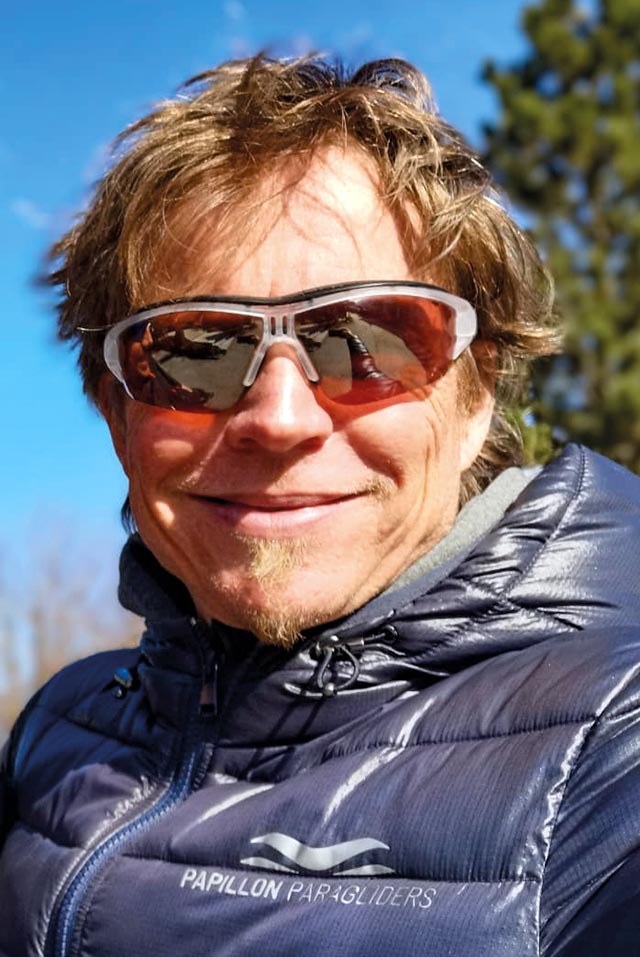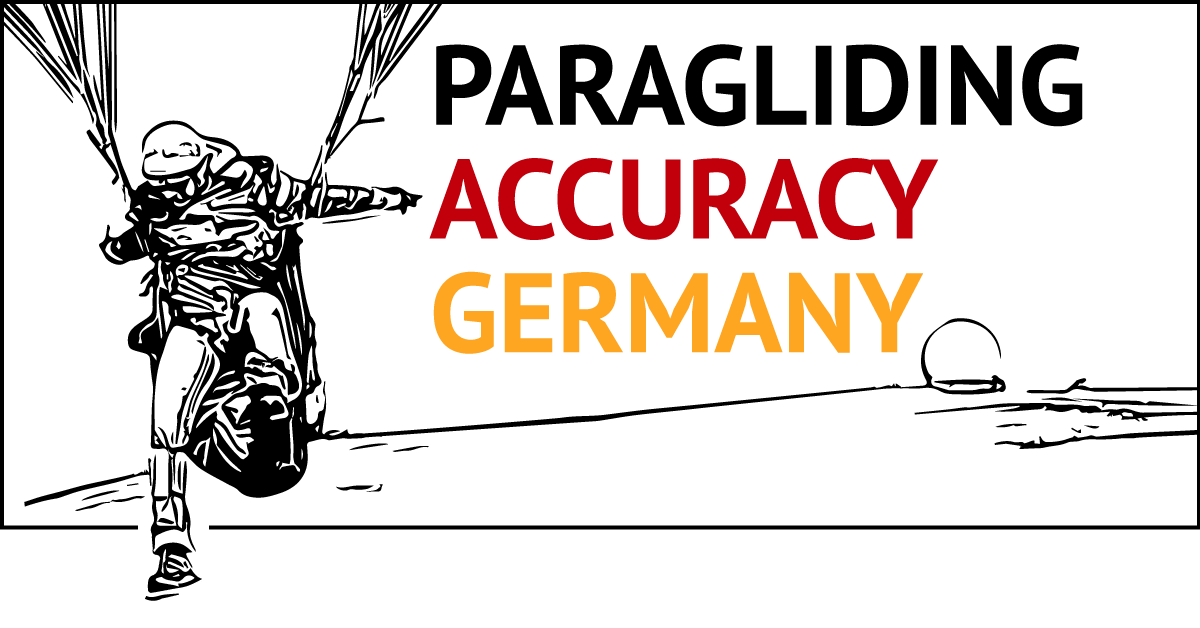Gleitschirm-Onlinemagazin (GOM): Hello Andreas, the home of the Papillon flying schools is the Wasserkuppe in the Hessian Rhön. So first of all, what makes the Wasserkuppe the “mountain of pilots”?
Andreas Schubert: The Wasserkuppe is the cradle of gliding – worldwide. Nowhere else does a mountain have so much to do with the history of flying. The first glider pilots took off on foot and with a rubber cable catapult. Hang gliders followed in the foot launch tradition in the 1970s. Today, paraglider pilots take off from the large, obstacle-free slopes around the aviation memorial on the Wasserkuppe, which are free from the wind – also on foot, just like the pioneers over 100 years ago.
Let’s take a quick look at some of the milestones in aviation on the Wasserkuppe and the history of the Rhön hang-gliding and paragliding schools:
- 1905 The first pilots take off from the Weltenseglerhang in the direction of the Fulda spring meadows.
- 1911 The first flying camps are set up on the Wasserkuppe.
- 1918 After the defeat against France, Germany is banned from motorised flying in the Treaty of Versailles. Gliding on the Wasserkuppe gains great military importance.
- 1923 The aviation memorial on the Wasserkuppe is inaugurated. The eagle on the memorial still faces west today, according to the ideology of the time towards the “true enemy of aviators” (France).
- 1923 Organisation of the first point landing competition
- 1923 Several gliding world records attract international attention.
- 1924 Foundation of the world’s first gliding school
- 1933 Foundation of the Reich gliding school
- 1950 Gliding is permitted again in Germany. The German Aeroclub is founded in the Hotel Peterchens Mondfahrt on the Wasserkuppe.
- 1970 The gliding museum on the Wasserkuppe is opened. Today it is the world’s largest gliding museum.
- 1975 Papillon is founded as an international hang gliding centre by hang gliding pioneer Uli Kroll.
- 1976 The first hang gliding competition in the Accuracy discipline takes place.
- 1994 Foundation of the Papillon paragliding school by Andreas Schubert and Uli Kroll.
- 1998 A section of the striking radar dome on the summit of the Wasserkuppe becomes the clubhouse of the Rhön hang-gliding and paragliding school.
- 1998 A Papillon branch is founded in South Tyrol. Since then, the Rhön Papillons have also taken off from the Tulperhof in the Lüsen Valley, 5 km from Brixen. The 25th anniversary will be celebrated on the mountain pasture in 2023.
- 1998 Papillon’s aeronautical engineering company starts work.
- 2000 Uli Kroll and Andreas found the “Rhöner- Drachen- und Gleitschirmflugschulen Wasserkuppe GmbH” from the two flight schools on the Wasserkuppe
- 2001 The company buys the two hotels “Deutscher Flieger” and “Peterchens Mondfahrt” on the Wasserkuppe.
- 2003 Ernst Strobl and Andreas Schubert develop the first Papillon Paragliders glider: The Bodyguard. The uncompromisingly safe wing was sold over 1000 times.
- 2004 The newly built “Wasserkuppe Flight Centre” is home to a centrally located paragliding shop with a very large selection, Europe’s largest flight school and the technical aviation operation all under one roof.
- In 2006 and 2007 Papillon expands its flight school programmes in the Sauerland and in the Stubaital in Austria.
- 2005 and 2007 Lennard and Linus Schubert are born. In 2024, they are ranked 2nd and 5th respectively in the FAI world rankings in the discipline of Paragliding Accuracy.
- In 2011, Papillon organises the first German-speaking Himalayan expedition with the aim of paragliding over Mount Everest. The expedition fails due to weather conditions. All the pilots return unharmed.
- In 2011, the paragliders on the Wasserkuppe celebrate their 100th anniversary. The first Paragliding World Cup final in the Accuracy discipline is organised on the Fliegerberg with great success.
- In 2018, the Bodyguard series is continued with the successful Bodyguard7 model from Papillon Paragliders.
- 2019 The story of Papillon Paragliders is made into a film. The film can be seen on the website www.papillon-paragliders.com
- In 2019 and 2023, the World Cup finals are once again held on the Wasserkuppe.
- Team Papillon Paragliders wins a World Cup, comes second several times and wins the overall World Cup in 2021. The Slovenian Matjaž Sluga is the world record holder with his Papillon Paragliders Raqoon.
- 2023 sees the addition of several international partners for Papillon Paragliders. In October, Linus Schubert becomes Vice World Champion with his Papillon Paragliders Himalaya.
GOM: What is your personal story?
Andreas: My personal history is very closely linked to Papillon. I have lived for flying – for 30 years. During this time, there have been successes, some of which I have already listed in the timeline of years. There have also been setbacks. Not everything has always worked out.
In 1997 and 1998, I flew in the XC league in Germany. I came third in Germany at the time and was able to win a couple of days. I had the feeling of being one in the air with Ernst Strobl’s Escape from UP. Nevertheless, I was not nominated for the 1998 World Championships in Pinzgau.
I immediately withdrew from the international competition and focussed my work on the company. I studied maths and physics from 1991 to 1996. My dissertation was the basis of today’s training script “Paragliding today”, which has of course been updated over the course of 25 years and has now been downloaded over 200,000 times. It is still highly recommended and is available as a free PDF download in German and English here.
We have been the largest flying school in Germany since 2000. I didn’t realise it at first, but there wasn’t a school anywhere that trained more students. Today there are much larger schools, but they mainly offer and conduct tandem flights. We are still a flying school that specialises in training. We are probably still the flying school with the most students.
The scene is not very big: we have about 15 pilots every week who complete their licence training. After that, however, most of them continue to fly with Papillon – travelling or on training courses. Some of the instructors who used to be in training now only offer flying holidays.
GOM: The name Papillon goes back to the film of the same name. What does Papillon stand for today?
Andreas: For experience and passion.
In a year, our instructors supervise around 100,000 flights. That’s an enormous wealth of experience, which ultimately also flows into the development of Papillon paragliders.
I always have to smile when test pilots tell me that they have built a new beginner’s glider. Our team recognises within a few days whether a paraglider lives up to its claims.
With our “Papillon Paragliders” brand, we are the manufacturer with the most EN-A paragliders in our portfolio. We know our way around this segment. Even the only tandem glider I know of with an EN-A rating is a Papillon Paragliders glider.
GOM: Which is the best-selling Papillon model?
Andreas: The Raqoon. My children learnt on it. I wouldn’t give any customer a device that didn’t have this level of safety. The Raqoon is also a world record glider – together with Matjaz Sluga, it has hit the pad 24 times in a row in competitions with a deviation of less than 5 cm. It can be flown very precisely and is therefore not only ideal for our student pilots and “off-and-on pilots”.
GOM: Does Papillon Paragliders also manufacture harnesses?
Andreas: There is a similar requirement here. Let’s look at the market as a very small niche market that is also highly competitive. I believe that you can only be successful if you offer your target group a really very good product.
Our harness expert, Jens Salomon, has customised and adjusted thousands of harnesses for just as many customers in tens of thousands of consultation hours. Based on this experience, he has launched a harness for occasional pilots that will certainly secure its place in the market for this segment. It is currently being finalised.
I think that we will gather the necessary experience in the spring to be able to launch the harness on the market. Based on the first prototypes alone, I am sure that we will then be able to offer a very sophisticated and comfortable harness for pleasure flying, thermal and soaring pilots. Our standards are very high: maximum comfort even on longer flights, very easy to get in and out of, low weight, robust material, high functionality despite the best possible elementalisation, attractive design, optimised safety concept…
GOM: Andreas, thank you very much for taking the time for this interview! Finally, one last question: How would you summarise the philosophy of the Papillon flight schools?
Andreas: Flying school is our passion. We enjoy training, we have friendly young instructors, brilliant practice slopes, a well-developed concept, lots of trips, training programmes – and we always have a lot of fun with the pilots ourselves.
See you UP in the sky!

Andreas Schubert
CEO Papillon, Pedagogue, German champion, 5th place in World Championships
I have been a passionate pilot, flight instructor and entrepreneur since my teacher training. I love working with and in this wonderful team.




